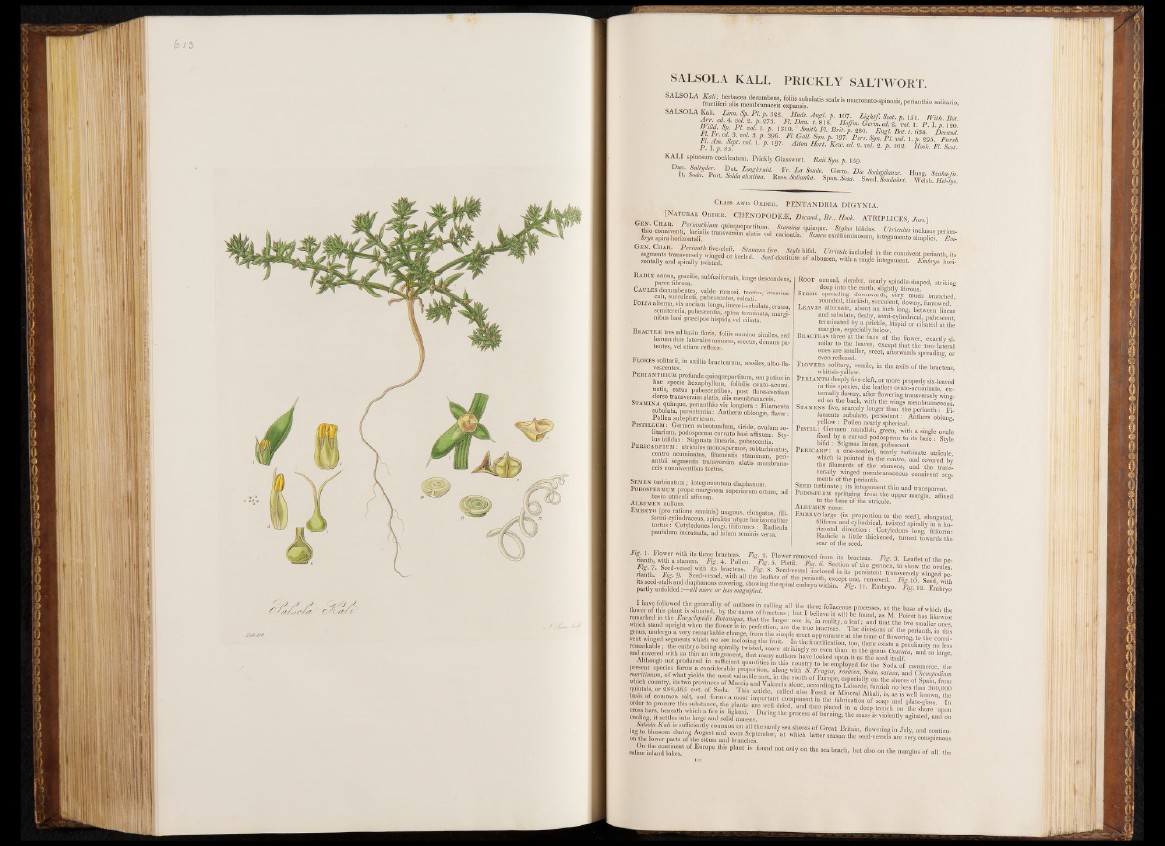
SALSOLA KALI. PRICKLY SALTWORT.
SALSOLA f « „ l a tis scabris mucronato-spinosis, perianthio solitaiio,
SALSOLA Kali. A n g lp . W Ê M U P- ■ W Ê f f l
U/-1JJj D/ 1 «80 , „ r‘ -tlojfm. berm.ed. 2. ©o/. 1; P . I. n iqo
F l F r ^ ' f L l S I 3Qß1 3 ra' Brit-P-Z i r .e a . y m l 3 .p. 396. FI. Gall. Syn.p. 197. PeSrOs-. SuEnn. gPlI. . Bvoolt.. t\.. v63 4£.95 L>ar.4
Ä Ä . Spf.. p. , 97. a * . ä. „ A A J02. h ó ïk Fl Z
KALI spinosum coclileatam. Prickly Glasswort. RaiiSyn.p. 159.
D “ : Ä t .
Class a nd Ord e r . PENTANDRIA DIGYNIA.
’ [Natueal Oe d e e . CHENOPODEÆ,' Decand., Br., Hook. ATRIPLICES J u u W L
° = B r 3 S “ '“ ^
Radix annu^ gracilis, subfusiformis, longe descendena,
parce fibrosa.
Cables decumbentes, »aide ramosi, teretes, crassius-
culi, succulenti, pubescentes, sulcati.
Folia alterna, vix unciam longa, lineari-subulata, crassa
semiteretia, pubescentia, spina terminate, margi-
mbus basi præcipue hispida vel ciliata.
BEACTEÆ 1res ad basin floris, foliis omnino similes, sed
narum duæ laterales minores, erectæ, demum patentes,
vel etiam reflexæ.
Flores solitarii, in axillis bractearum, sessiles, albo-fla-
vescentes.
Pe r ia n th iom profunde quinquepartitum, seu potius in
hac specie hexaphyllum, foliolis ovato-acumi-
natis, extus pubescentibus, post florescentiam
dorso transversim alatis, alis membranaceis.
Stamina quinque, perianthio vix longiora : Filamenla I
subulata, persistentia : Antheræ oblongæ, flavæ •
Pollen subsphæricum.
PlSTlLLüM : Germen subrotundum, viride, ovulum so-
litarium, podospermo curvato basi affixum : Sty-
lus bifidus : Stigmata linearia, pubescentia.
Pe rica rpiüm : utriculus monospermus, subturbinatus,
centro acuminatus, filamentis staminum, peri-
antbii segmentis transversim alatis membranaceis
eonniyëntibus tectus.
Semen turbinatum ; integumentum diaphanum.
Podospermum prope marginem superiorem ortum, ad
/ basin utriculi affixum.
Albumen nullum.
Embryo (pro ratione seminis) magnus, elongatus, fili-
formi-cylindraceus, spiraliter atque horizonteliter
tortus : Cotyledones longi, filiformes : Radicula
paululum incrassata, ad hilum seminis versa.
Root annual, slender, nearly spindle-shaped, striking
deep into the earth, slightly fibrous.
Stems spreading downwards, very much branched
rounded, thickish, succulent, downy, furrowed ’
L eaves alternate, about an inch long, between linear
and subulate, fleshy, semi-cylindrical, pubescent,
terminated by a prickle, hispid or ciliated at the
margins, especially below.
Bracteas three at the base o f the flower, exactly similar
to the leaves, except that the two lateral
ones are smaller, erect, afterwards spreading, or
even reflexed. °
Flowers solitary, sessile, in the axils of the bracteas,
whitish-yellow.
P e e ia n t u deeply five-cleft, or more properly six-leaved
IO this species, the leaflets ovato-acuminate, externally
downy, after flowering transversely wine-
ed on the back, with the wings membranaceous.
Stamens five, scarcely longer than the perianth : Filaments
subulate, persistent: Anthers oblong
yellow : Pollen nearly spherical. 6’
P ist il : Germen roundish, green, with a single ovule
fixed by a curved podosperm to its base : Style
bifid : Stigmas linear, pubescent.
P e r ic a r p : a one-seeded, nearly turbinate utricule,
which is pointed in the centre, and covered by
the filaments of the stamens, and the transversely
winged membranaceous connivent segments
of the perianth. 6
Seed turbinate; its integument thin and transparent.
P odosperm springing from the upper margin, affixed
to the base o f the utricule.
Albumen none.
E mbryo large (in proportion to the seed), elongated,
filiform and cylindrical, twisted spirally in a horizontal
direction : Cotyledons long, filiform:
Radicle a little thickened, turned towards the
scar of the seed.
Fig. ]. Flower with its three bracteas. Fig. 2 . Flower rpmov^H t „ _.
rianth, with a stamen. Fig. 4 . Pollen Fig 5 Pistil Flo- « <? -fr bracteas. Fig. 3. Leaflet of the pe-
r ig . 7. Seed-vessel with ifs brectos i ^ S S e ^ v t s 5e f L L S i n l ° L ? tST f D- 16 sh°,»th.e °™>“ -
nnnth. 1%. 9. Seed-vessel, with all tlie leaflets of the plianUr, except one removed STn' HI 19
>■- E m b ^ o . \ ° i 2 ImbT^o
gene, undergo n°v<ny remarkable change, S im p l e erect ‘■ H “>? P™ ° ‘b, in this
Although not pioduced m sufficient quantities in this country to be emoloved for the SnH« nf A„m ,
r f i - = i - 5 '^ s i S £ * s
cross bars, beneath which a fire is lighted. Daring the process of hnrei™ th. d“ p- “f th-e sl‘°,c "P°“
cooling, it settles into large and solid masses. 8 P “ ^ U 18 vlolently agitated, and on
. Kn/i is sufficiently common on all thesandy sea shores of Great Rritain ,
mg to blossom during August and even Sentember nt vl i.b 1^ flP"'eringin July, and continuon
the lower parts o f the stems and branch« ktteI seas™ the seed-vessels are very conspicuous
saline Wan“ Ink“ ' " * * ^ U f“""d not °"!J “ « - - beach, but also on the margins o f all the